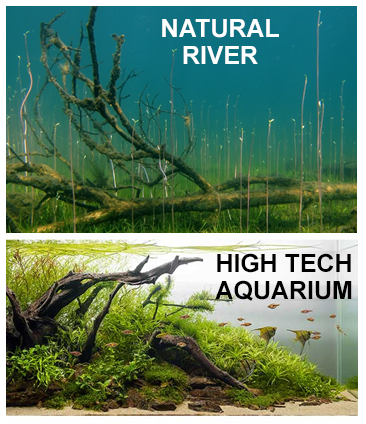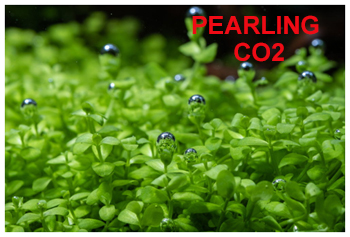Planted Aquariums:
Low-Tech Vs High-Tech
If you are just starting to keep water plants in your aquarium, you will quickly learn that many people will distinguish between two types of planted aquariums, low-tech and high-tech. What is the difference? Can I keep the plants I want in a low-tech tank? Will the plants look better in a high-tech tank? How much more work is a high-tech tank? How much more money is a high-tech tank? Can I add tech over time? We will try to answer these questions today.
What is the difference between a high-tech tank and a low-tech Tank?

High-tech planted aquariums use various “high-tech” equipment to grow plants exceptionally well. Plants can still grow in a much more basic aquarium but they often won’t look as good or grow as fast, and you may struggle to grow some sensitive plant species. No river or lake has dosing pumps or a CO2 system attached to it, but in reality, natural planted scenes often don’t look as perfect as the artificial scenes we can create in a high-tech aquarium. Notice how much algae is growing on the piece of natural driftwood in the top photo taken in a river vs the perfectly pristine driftwood in the bottom photo taken in a high-tech aquarium. Both scenes are beautiful, but perfectly algae-free wood and plants without any dark leaves and strong vibrant greens are nearly impossible to achieve without the high-tech equipment used in modern planted tanks.
What tech is high-tech? Can I add tech over time?
In general, five categories of tech distinguish high-tech tanks from low-tech tanks. Some of this tech can be easily added over time while some is best to start with from the beginning.
- Soil Substrate
- Plants simply grow better in a dirt-like substrate than in gravel. Because substrate is at the literal foundation of your aquarium it is very difficult to switch a substrate out once a tank is running. Using a soil-like substrate such as Seachem Flourite or CaribSea Eco Complete will give your plants fertilizer through their roots and it is softer than gravel making it easier for the roots to penetrate into the substrate. Some plants such as sword plants get the majority of their nutrients through their roots and will disproportionately benefit from a soil substrate.
- RO Water
- Some local tap water is very good for growing plants but some is just simply awful. Hard water is particularly bad for growing plants. From personal experience switching from our extra hard water to RO water led to a near doubling of the plant growth in our tanks. Plants do need some minerals to grow so it is best to add them back with an additive. You can add Brightwell Remineralize P to your RO water to make sure that the necessary minerals for plant growth are included. For planted aquariums, you do not need one of those extremely expensive RO Systems designed for reef aquariums. A basic RO system such as the Aquaticlife RO Buddie will be plenty to allow you to make your own RO water. You can also purchase RO water by the gallon at most local aquarium stores, or grocery stores.
- If you have been using tap water and want to switch to RO water you can do so but make sure to do so slowly to avoid shocking your tank with a big change in water hardness or pH. Start by switching your tank top-off water to RO water and then do small 10% water changes until the hardness of your tank matches the hardness of your RO water or remineralized RO water.
- Pressurized CO2

- Many would consider a pressurized CO2 system the primary factor in differentiating a high-tech tank and a low-tech tank. Pressurized CO2 can greatly increase your plant’s growth rate and help to bring out beautiful colors.
- Plants need water and CO2 to photosynthesize. Land plants have plenty of CO2 from the atmosphere, but they need to be watered. Water plants have plenty of water but they have a hard time getting CO2. In this regard, you can think of adding CO2 to your water plants like watering your land plants. In a low-tech tank, plants get their CO2 from air that dissolves in the water from the atmosphere from air pumps or surface agitation, as well as from the respiration of fish. Fish breathe dissolved oxygen with their gills and then expel dissolved CO2 when they breathe out, just as we do when we breathe on land.
- In a high-tech tank Co2 gas is injected into the aquarium water to boost CO2 to extraordinary levels. For more information on how to set up a CO2 system see our CO2 system overview. The added CO2 can lead to excellent plant growth, reduced algae, and in some cases plant pearling. Pearling is when water plants photosynthesize so fast that you can see oxygen accumulating and bubbling up on the plant leaves. This is very beautiful and a sign that your plants are very happy. We have never seen plants pearl in a tank without pressurized CO2.
- A pressurized CO2 system can be added to any planted tank but the amount of CO2 you can add is related to how fast your plants are growing. In tanks with less intense light or very little fertilizer additions, you won’t be able to crank up the CO2 much without risking suffocating your fish. Because of this, most people who add a pressurized CO2 system will also use powerful lights and add a large amount of fertilizers.
- High-Intensity Lighting
- Plants need lighting to photosynthesize and grow. Many plants can live under the most basic aquarium lights but some will require more intense light and other plants will not display their full growth potential or vibrant colors unless they are given lots of light. Some dedicated planted lights such as the Fluval Fresh and Plant 3.0 can work for larger low-tech tanks that need a bit more intense lighting but for very powerful and intense lights such as the Kessil planted lights. These lights will almost always necessitate adding a CO2 system and fertilizer dosing. With very intense lights and no CO2 and fertilizer additions, the extra strong light can encourage severe algae problems. Because of this we only recommend buying very intense lighting if you are also going to use pressurized CO2 and add fertilizers.
- Fertilizer Dosing
- For plants to grow they need light, CO2, and fertilizer. In Low Tech planted tanks the fertilizer comes from fish poop. In High Tech planted tanks plants grow so fast that fish poop alone is not enough. In a high-tech tank adding fertilizers like Seachem Flourish, Flourish Iron, Flourish Nitrogen, and Flourish Phosphorus is very common. Because plants use fertilizers all day long it is typically best to add fertilizers on a daily basis. Given the amount of work involved in dosing 3-4 different fertilizers daily, this is a process that is often automated by a programmable dosing pump such as a Kamoer F1 or F4. These dosing pumps can be programmed to add a specific amount of liquid additive multiple times a day. This evens out the dose and reduces the maintenance of adding the liquid daily.
- You can add fertilizers to any tank but before you do measure your aquarium nitrate and phosphate levels if you have elevated levels of nitrate and phosphate there is no reason to spend money on fertilizers. The elevated levels indicate that there is plenty of available nitrogen and phosphorus in the water plants to use. If you test your water and these elements are zero or near zero then you need to add more fertilizer to the water. The zero level means that all of the available nitrogen and phosphorus has been stripped out of the water by your plants and they are wanting more.
How much more work is a high-tech planted tank?
A high-tech planted tank is likely the most maintenance-intensive aquarium type there is. When water plants are given ideal conditions, they can grow very fast and will require frequent trimming. It is not uncommon to pull out a basketball-sized bundle of plant trimmings every week from a large planted tank. For some, this can be very rewarding but for others, it is more than they are wanting to do. If you are worried about a high-tech tank becoming too much work. Purchase a dimmable light. If you reduce the amount of light this will lower the rate of photosynthesis reducing the amount of CO2 and fertilizers you will need to add and the plants will require less trimming. Just be aware that slower growth normally also means less vibrant plants and some plants will require high light and high CO2 conditions in order to live.




























 High-tech planted aquariums use various “high-tech” equipment to grow plants exceptionally well. Plants can still grow in a much more basic aquarium but they often won’t look as good or grow as fast, and you may struggle to grow some sensitive plant species. No river or lake has dosing pumps or a CO2 system attached to it, but in reality, natural planted scenes often don’t look as perfect as the artificial scenes we can create in a high-tech aquarium. Notice how much algae is growing on the piece of natural driftwood in the top photo taken in a river vs the perfectly pristine driftwood in the bottom photo taken in a high-tech aquarium. Both scenes are beautiful, but perfectly algae-free wood and plants without any dark leaves and strong vibrant greens are nearly impossible to achieve without the high-tech equipment used in modern planted tanks.
High-tech planted aquariums use various “high-tech” equipment to grow plants exceptionally well. Plants can still grow in a much more basic aquarium but they often won’t look as good or grow as fast, and you may struggle to grow some sensitive plant species. No river or lake has dosing pumps or a CO2 system attached to it, but in reality, natural planted scenes often don’t look as perfect as the artificial scenes we can create in a high-tech aquarium. Notice how much algae is growing on the piece of natural driftwood in the top photo taken in a river vs the perfectly pristine driftwood in the bottom photo taken in a high-tech aquarium. Both scenes are beautiful, but perfectly algae-free wood and plants without any dark leaves and strong vibrant greens are nearly impossible to achieve without the high-tech equipment used in modern planted tanks.
